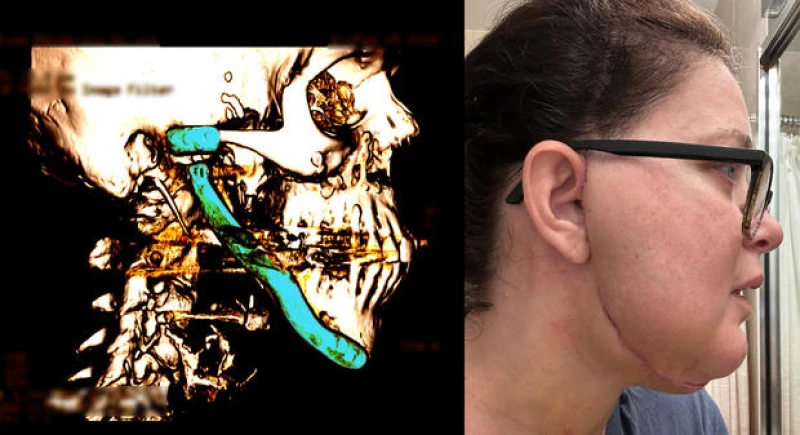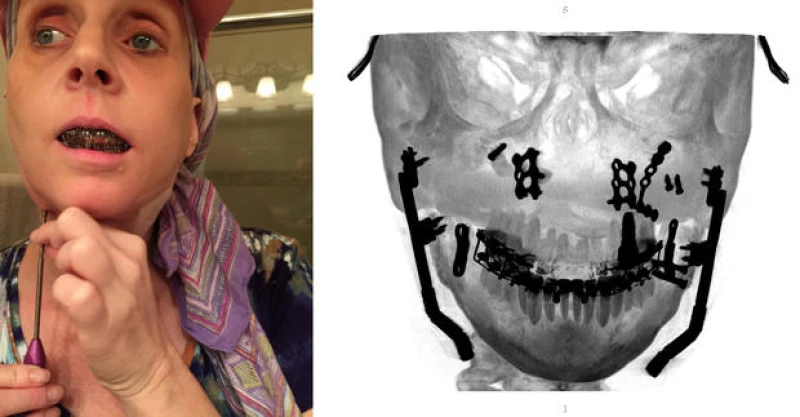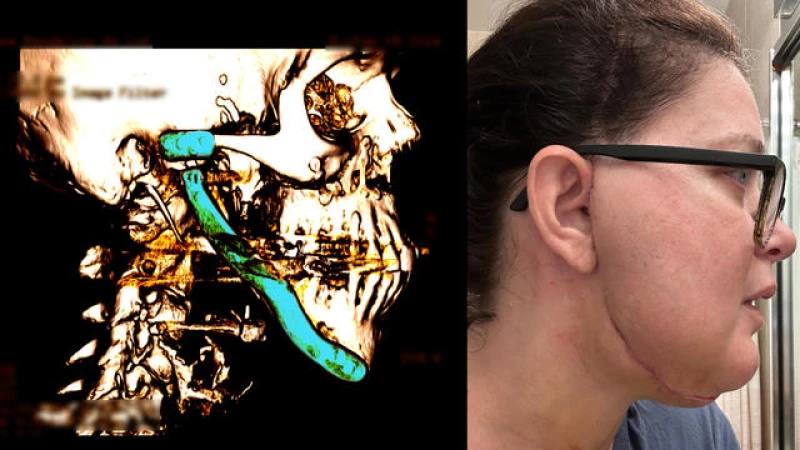A TMJ patient in Maine had six surgeries to replace part or all of the joints of her jaw.
Another woman in California, desperate for relief, used a screwdriver to lengthen her jawbone daily, turning screws that protruded from her neck.
A third in New York had bone from her rib and fat from her belly grafted into her jaw joint, and twice a prosthetic eyeball was surgically inserted into the joint as a placeholder in the months it took to make metal hinges to implant into her jaw.
"I feel like Mr. Potato Head," said Jenny Feldman, 50, of New York City, whose medical records show she's had at least 24 TMJ-related surgeries since she was a teenager. "They're moving ribs into my face, and eyeballs, and I feel like a toy … put together [by] somebody just tinkering around."
These are some of the horrors of temporomandibular joint disorders, known as TMJ or TMD, which afflict up to 33 million Americans, according to the National Institutes of Health. Dentists have attempted to heal TMJ patients for close to a century, and yet the disorders remain misunderstood, under-researched, and ineffectively treated, according to an investigation by KFF Health News and CBS News.
Dental Care for TMJ Patients Can Lead to Harmful Treatments, Including Metal Jaw Joints

Individuals suffering from TMJ disorders may find that dental care intended to help them can actually do more harm than good. Some patients end up in a cycle of ineffective surgeries that could ultimately result in their jaw joints being replaced with metal hinges. This alarming information comes from medical and dental experts, patients, and advocates who shared their experiences in interviews and video testimonies submitted to the FDA.
TMJ disorders are known to cause pain and stiffness in the jaw and face, varying from mild discomfort to severe disability, with women more commonly experiencing severe symptoms. Traditionally, dentists have treated this condition with splints and orthodontic procedures. However, these treatments are often based on "strongly held beliefs" rather than solid scientific evidence, as noted by the National Academies of Sciences, Engineering, and Medicine after reviewing decades of research. The NIH also cautions that there is limited evidence supporting the effectiveness of splints in reducing pain and advises against any treatment that permanently alters the teeth, bite, or jaw.
Rena D'Souza, director of the NIH's National Institute of Dental and Craniofacial Research, expressed concerns about the lack of understanding surrounding TMJ disorders, stating, "I would say that the treatments overall have not been effective, and I can understand why. We don't understand the disease."
As part of an investigative report, journalists from KFF Health News and CBS News spoke with 10 TMJ patients suffering from severe symptoms. These individuals described feeling trapped in a cycle of escalating treatments that began with splints or dental procedures and progressed to multiple surgeries yielding diminishing results and diminishing hope.
Patients Speak Out About TMJ Treatment
During interviews, patients revealed that their TMJ pain worsened throughout their treatment, leading to regrets about the care they received.
"The grand irony to me is that I went to the doctor for headaches and neck pain, and I've had 13 surgeries on my face and jaw, and I still have even worse neck pain," shared Tricia Kalinowski, 63, of Old Orchard Beach, Maine. "And I live with headaches and jaw pain every day."
TMJ, an umbrella term for around 30 disorders affecting 5% to 10% of Americans, can range from minor symptoms that resolve on their own to severe cases causing chronic pain that interferes with daily activities like eating, sleeping, and talking.
In a recent comprehensive study on TMJ disorders involving input from over 110 patients, experts highlighted the lack of training among health care professionals, including dentists, when it comes to managing TMJ. Patients often face harm from overly aggressive treatments and the absence of proven solutions.
The American Dental Association, which sets guidelines for the dental profession, acknowledged the challenge of managing TMJ disorders, stating that they are more often managed than cured. The ADA expressed optimism about ongoing research efforts to explore new treatment options for TMJ patients.
"Lack of Understanding"
Historically, TMJ disorders have been a challenging issue for many patients, with a lack of effective treatments. Terrie Cowley, a TMJ patient and leader of the TMJ Association, expressed her disillusionment with the current state of dental care for TMJ. She often advises patients to avoid treatment due to the lack of progress in the field.
Cowley highlighted the frustration felt by many patients, stating, "Almost 100 years this has been in dentistry, and look at what we have. A whole ton of people pretending they know everything, and we don't know anything."
Research has shown that TMJ disorders are more prevalent in women, especially those in their 20s and 30s, possibly due to hormonal factors. However, the true cause of TMJ disorders remains unclear. Kyriacos Athanasiou, a professor at the University of California-Irvine, pointed out that the historical dismissal of TMJ disorders as not serious or complex, particularly because they affect women more, has hindered research progress.
In a recent study, Athanasiou and his team found a significant disparity in research focus between the jaw joint and other joints like the knee. Despite the jaw joint's complexity, it receives far less attention in research and funding.
Experts like D'Souza acknowledge that TMJ disorders, along with other conditions that predominantly impact women, have not been taken seriously for many years, leading to a lack of understanding and effective treatments.
"The long-standing bias has significantly impacted the advancement of research," she expressed. "This bias has also negatively affected patients seeking treatment for TMJ."
Female patients have shared their experiences of feeling patronized or trivialized by male healthcare providers during their TMJ treatment. Some mentioned feeling blamed for their own pain, being labeled as overly stressed and clenching their jaw excessively.
"We urgently require research to uncover why more women are affected by TMJ disease," stated Lisa Schmidt, a TMJ Association board member, in a 2021 newsletter from the organization. "Surgeons must refrain from attributing this condition solely to women."
Having been diagnosed with TMJ disorder in 2000 due to headaches, Schmidt, 52, from Poway, California, shared that an orthodontist promptly suggested a splint, braces, and surgery.
However, after wearing the splint for just three days, Schmidt experienced intense pain and struggled to open her mouth wide enough to eat solid food. This led to 17 years of undergoing various surgeries without relief, ultimately forcing her to give up her career as an aerospace scientist collaborating with NASA astronauts.

Lisa Schmidt shared her harrowing experience with TMJ care, recalling a distressing incident in 2016. In an attempt to address previous bone loss due to surgeries, a surgeon inserted long screws into her jaw that extended downwards through her neck. Schmidt described the painful process of tightening these screws daily with a screwdriver for nearly three weeks, only to find that the treatment was ineffective and left her in even more agony.
"Every surgery seemed to exacerbate my pain," Schmidt lamented. "If I could advise my younger self, I would simply say 'Run!'"
Insufficient Evidence in TMJ Care
An eye-opening report on TMJ care highlighted numerous deficiencies in the treatment of this condition, published by a group of experts from prestigious institutions such as Harvard, Duke, and Johns Hopkins universities in March 2020. Unfortunately, the report received little attention amidst the COVID-19 pandemic.
Sean Mackey, a professor from Stanford involved in the study, emphasized that patients with TMJ disorders often faced unnecessary and expensive treatments that lacked substantial evidence of effectiveness. Instead of focusing on proven pain management strategies, individuals were frequently directed towards futile procedures.
"Our findings reveal a complex situation," Mackey stated. "There's a problematic trend in our society where procedures are prioritized over meaningful patient interactions. Some of these interventions, including surgeries, offer little benefit to those suffering from TMJ issues."
Reports from the national academies have revealed a long-standing assumption in the dental field regarding TMJ disorders. For over 50 years, it has been widely believed that misaligned bites cause TMJ disorders, leading to treatments that focus on the teeth and bite. However, a recent study highlighted a lack of sufficient evidence to support this claim.
As a result, treatments that involve permanent changes to the bite, such as braces, crowns, or teeth grinding, have been deemed to have "no supporting evidence" according to the national academies report. The NIH also cautions against these treatments, stating that they are ineffective and may exacerbate the issue.
The most common TMJ treatment, dental splints, are also known as night guards or mouth guards. These removable dental appliances are custom-molded to fit over the teeth and can be quite costly, ranging from hundreds to thousands of dollars out-of-pocket. Despite their prevalence, splints typically undergo the FDA's 510(k) clearance process, which does not mandate individual effectiveness testing before market approval.
Other treatments fare no better. The FDA has not labeled any drugs specifically for TMJ disorders, and pain medicines can be too weak or addictive to be a long-term solution, according to the TMJ Association. Botox injections may ease pain but have raised concerns about bone loss during animal testing. The NIH warns that minor surgeries that flush the jaw with liquid bring only temporary pain relief and that more complex surgeries should be reserved for severe cases because they have yet to be proved safe or effective in the long term.

To improve care, the national academies called for better education about TMJ disorders across medicine and dentistry and more research funding from the NIH, which has a "ripple effect" on research and training across the nation.
Since the 2020 report, the NIH has launched a TMJ research collaborative and increased annual research funding from about $15 million to about $34 million, D'Souza said. TMJ care was added to the standards that dental schools must teach to be accredited in 2022. The national academies launched an ongoing forum on TMJ disorders last year.
Despite the significant impact of TMJ, funding for research and treatment lags behind other medical conditions. While the NIH allocates billions of dollars each year to study diseases like cancer and heart disease, which affect many Americans, only a fraction of that amount goes towards TMJ research. Additional funding is directed towards less life-threatening conditions such as arthritis, back pain, eczema, and headaches.
It is important to note that the allocation of NIH funding is influenced by decisions made by Congress. As Dr. Mackey pointed out, advocating for increased funding for TMJ research is crucial. By voicing concerns and reaching out to legislators, individuals can help raise awareness about the need for more resources in this area.
Options for severe cases
For individuals experiencing severe TMJ symptoms that do not respond to traditional treatments, there is a final option available: total jaw replacements. This procedure involves replacing the jaw joint with synthetic implants, either by replacing the cartilage disk within the joint or using a metal hinge attached to the skull bones through "total joint replacement surgery."
However, the history of jaw implants is marked by challenges. In the 1990s, several disk implants were recalled or discontinued due to safety issues. Today, TMJ implants are closely monitored by the FDA, as failures can lead to adverse health effects. Currently, Zimmer Biomet and Stryker are the only companies selling total jaw replacement implants in the United States.
Zimmer Biomet has been producing its implant for over twenty years, touting it as a safe and effective option for patients in need of jaw joint replacement. This need may arise from TMJ disorders, unsuccessful surgeries, injuries, or other medical conditions. According to FDA spokesperson Carly Pflaum, a study mandated by the FDA in 2017 revealed that approximately 14% of patients who receive the Zimmer Biomet implant require further surgery or removal within a decade.
Stryker, on the other hand, acquired a company in 2021 that manufactured a total jaw replacement implant and now manufactures the implant itself. Despite the NIH's recommendation since at least 2022 for TMJ patients to steer clear of surgery, Stryker launched a patient-oriented website for the implant last year. The company is also enlisting surgeons to join a "surgeon locator" feature on the site, as evidenced by posts on Facebook and LinkedIn.
Although a study on the success rate of the Stryker implant was mandated by the FDA and finalized in 2020, the results have not been disclosed by the agency.
According to D'Souza, an official at the NIH, her professional experience leads her to believe that the majority of total jaw replacement surgeries are not ultimately successful.
"The success rate is low," D'Souza remarked. "It is not very encouraging."
Several patients shared their medical records with KFF Health News and CBS News, revealing that their total jaw replacement implants had to be extracted due to various issues such as malfunction, infection, or previously unknown metal allergies. Some of these patients disclosed that they have been living without a jaw hinge since the removal of their implants, which took place months or even years ago.
Kalinowski, a TMJ patient in Maine, has undergone six jaw joint replacements, including four implants. Her medical records detail the replacement of the cartilage disk on her right side in 1986 with an implant that was later recalled, and again in 1987 with another that was later discontinued. In 1992, her left and right disks were replaced with a muscle flap and rib graft, respectively, and her entire right joint was replaced with another implant that was later discontinued in 1998. Both joints were replaced again in 2015.
Despite the functional artificial jaw, Kalinowski continues to experience pain and is unable to move her jaw from side to side. Her mouth remains open at rest, and she opts for protein shakes for lunch due to the difficulty of consuming solid food.
The most devastating consequence, according to Kalinowski, is the nerve damage on her lower face caused by the surgeries, leading to the loss of sensation and the inability to feel her husband's kisses since the '90s.
"If there was one moment in my life I could take back and do over again, it would be that first surgery. Because it set me on a trajectory," Kalinowski expressed. "And it never goes away."
CBS News producer Nicole Keller contributed to this article.
KFF Health News is a national newsroom that produces in-depth journalism about health issues and is one of the core operating programs at KFF — the independent source for health policy research, polling, and journalism.







